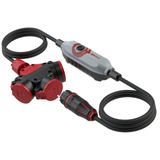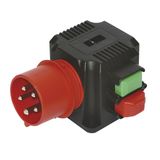PCE Circuit Breakers











In low-voltage distribution, correct modular protection defines how safely a system handles overload, fault current, and transient surge. PCE breakers and DIN modular devices are built for standard 35 mm rails, follow EN 60898 and EN 61008 standards, and maintain mechanical endurance above 20 000 operations. Every breaker or RCD must not only trip — it must trip predictably, under repeat load. That’s where PCE’s design focus shows: calibrated bimetal elements, consistent torque tolerances, and properly rated terminal cages.
Choosing PCE MCB and RCD combinations for balanced protection
PCE MCB and RCD units form the backbone of modular protection. Miniature Circuit Breakers (MCB) handle short-circuit and overload up to 10 kA breaking capacity, typically from B-curve 6 A to C-curve 63 A. Residual Current Devices (RCD) protect against earth leakage from 10 mA to 300 mA sensitivity. Combined RCBO variants integrate both protections in one 1P+N or 2P module, saving space on crowded rails.
In practice, electricians prefer separating lighting and socket circuits on individual B-curve 10 A or 16 A MCBs, while heavier inductive loads (motors, HVAC) use C-curve 20–32 A. Always check rated short-circuit capacity against the supply’s fault level — 6 kA is enough for residential, 10 kA for commercial feeders. For RCDs, select 30 mA for personal protection, 100–300 mA for fire or equipment isolation. PCE’s modular system uses common busbar pitch, simplifying parallel wiring and reducing contact losses over time.
Installation practice — torque, spacing, and line marking
Many failures in DIN panels come not from the device, but from wrong installation. For PCE breakers, terminal torque is 2.0 Nm on 16–63 A models. Copper conductors 1.5–25 mm² fit under cage clamps without ferrules; however, always use properly stripped ends, 11 mm length for single wires. Leave 5–10 mm ventilation gap between devices if cabinet runs at high ambient above +40 °C. Each device is laser-marked with tripping curve and rated short-circuit current — verify it during acceptance testing.
Label outgoing circuits directly on the PCE device label space; use self-adhesive transparent overlays for moisture protection. Avoid mixing busbar types (pin vs fork) inside one row — that’s the number one cause of loose contact heating.
PCE Modular Protection — distribution logic that scales with the project
PCE modular protection means you can scale a panel from six circuits to sixty without redesign. Every module shares the same 45 mm height and DIN-profile width, with side interlocks that ensure stable alignment. PCE’s frame stiffness prevents bending on long busbar runs.
For large installations, modularity saves cost in two places: first, spares inventory stays standard; second, any field technician can replace a device without tools beyond a flat screwdriver. Each breaker includes visual ON/OFF indication and trip flag; RCDs include a manual TEST function to verify residual trip path. Most models carry CE and KEMA certification, so they fit in multinational documentation packages without additional testing.
Procurement specialists appreciate the unified part-number logic — the same code base applies from 1-pole 6 A up to 4-pole 63 A; suffixes define curve and sensitivity. That makes ERP integration simple and avoids confusion in multi-country projects.
PCE Surge Protection Modules — protecting electronics from transient peaks
Transient surges caused by switching, lightning, or unstable grids can destroy sensitive electronics even when breakers survive. PCE surge protection modules (SPD Type 2 and Type 3) handle these impulses before they propagate. Nominal discharge current 20–40 kA per pole, max discharge 60 kA, response time < 25 ns. Thermal disconnect indicators show when cartridges must be replaced.
Always install SPDs on the supply side, as close as possible to the incoming main breaker. Use short leads (< 30 cm) for both phase and earth to minimise inductive impedance. In three-phase systems, protect all active conductors plus neutral; in TN-S or TT networks, ensure correct earthing path. Combine SPD Type 2 at the main board with Type 3 at terminal distribution or sensitive loads. Regular inspection after storms or maintenance cycles is mandatory — replace modules that show mechanical flag or test value deviation.
Maintenance and procurement guidelines for B2B buyers
To standardise procurement of PCE breakers and DIN modular devices, follow a few rules:
- Always specify rated voltage (230/400 V AC) and tripping curve (B, C, D).
- Order complete row sets for each panel to keep consistent mechanical alignment.
- Maintain 5 % extra breakers and 2 % RCDs in spare stock for field replacements.
- Verify lot numbers and CE certificates for each shipment — PCE devices include batch QR code for traceability.
- Store breakers upright; prolonged horizontal stacking may deform the spring tension.
- Train maintenance teams to retorque terminals annually on high-load circuits.
Lead time across EU typically 3–5 days from Latvia stock. All models come in 6–12-unit cartons; RCDs and SPDs have protective foam packaging to preserve calibration. Warranty 24 months from invoice date with full conformity documentation.
Why choose Bank of Lamps
Official European distributor with stock in Latvia
Direct B2B supply across EU including Germany, France, Netherlands, Spain, Baltics
Certified documentation and full manufacturer warranty
Fast dispatch from central warehouse
No project design or custom builds — only verified wholesale distribution